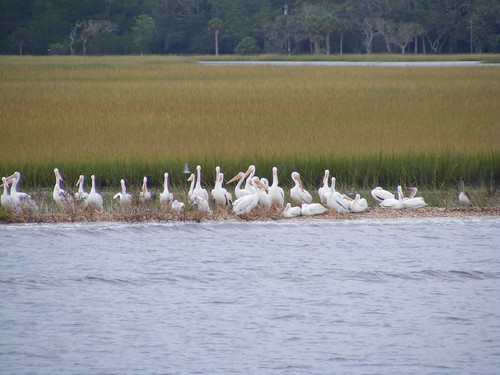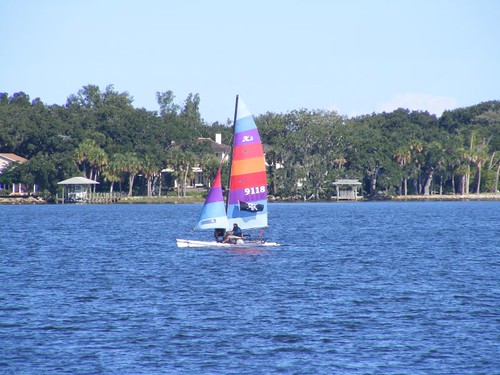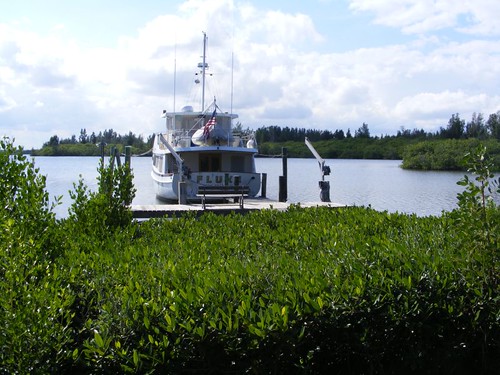October 27 – November 2, 2009The Savannah River is the dividing line between South Carolina and Georgia. The ICW crosses straight over it, and there is a big intersection there because the Savannah River is the main shipping channel used by ocean going vessels to go up to Savannah for trade purposes.
As we approached that intersection we could hear radio traffic from an incoming freighter who was working his way up the river to the same intersection we were headed to on our ICW route. We do not use our radar during the day in clear conditions, so we weren't sure how close we would be to the freighter at the intersection. You can't just look down the river to see if any boats are coming because the view is blocked by trees. Wayne called the ship on the radio to ask how long it would be until he got there, wondering if we could get through ahead of him. He was very polite and gave us the time, and stressed that we shouldn't pull out in front of him if there was any doubt that we wouldn't be out of his way in time. We had doubt so we waited and watched the fully loaded freighter, PRESIDENT POPE, slowly pass right in front of us.
As soon as you cross into Georgia from the north you are treated to some of the interesting sites associated with the historic Savannah area. One of my favorites is the huge Bonaventure cemetery whose beautiful, expansive grounds and monuments grace the banks of the ICW. There is a lot of history and mystery in those graves, and I suspect a varied sort of activities have occurred on top of them too. Not far away are the little towns of Thunderbolt and Isle Of Hope packed with marinas, and lots of boats of all sizes, shapes, and models for us to gawk at.
We anchored in the Vernon River, an offshoot of the ICW, south of the Isle Of Hope. One side was marsh and the other side was lined with single family homes, most with boats. We sure were surprised to see a Krogen Manatee, a smaller version of FLUKE, docked a stone's throw from where we set the hook. Several shrimp and fishing boats were also anchored in the river.
When we tried to start the generator to run the water heater and supply some galley power it wouldn't stay running. It had run normally early in the morning when we were pulling up the anchor. The WE Marine Maintenance Team jumped right on it to try to diagnose the problem, but were unable to fully remedy the situation. That meant we would have to be creative, and not as comfortable, for the few days it would take us to get back to Vero. We could cook with gas, so I would plan meals that would be applicable to that use. We would not be able to heat the hot water tank, and cold showers wouldn't be that bad since the temperatures were warming up into the 80s anyway.
The other thing we use the generator for is air conditioning, both heating and cooling. It's not just for comfort, but to try to keep the boat dry. Did we ever need it the day following the generator breakdown. It was overcast, hot and so humid, the hottest day since leaving Virginia. The downstairs interior of the boat had remained very cool and mostly dry since we had had no need to fully open it up. By midday, the interior had begun to heat up and with all the humidity, water condensed on EVERY surface, even behind the sitting cushions. The walls, mirrors, and cabinets were very wet. If you brushed up against anything your clothes got wet. It was a mess. I'm sure we'll be discovering a lot of mildew in places we haven't seen it before, including our clothing.
St. Catharines Inlet runs very close to the ICW, and it wasn't far from the Vernon River anchorage. Seas were forecast in the 3-4' range early and then settling down later, with little wind. We decided to head out to sea with the idea of traveling all the way down to Cape Canaveral, Florida where we had gone out to sea two months earlier. In so doing, we would be able to avoid the shallows and twisting turns of the waterway as it meanders through Georgia.
Seas and winds were what was forecast, but we had an uncomfortable swell from the SE that persisted for 7 hours. Poor Visitor vomited, and Eddie was worried he wasn't far behind. I told him to just get comfortable and don't worry about helm duty, so he huddled in his bunk for the whole day. The water was too shallow for us to do any trolling, and even if it was deep enough, I don't think I would have felt good enough to set up all the gear anyway. Even though the water had calmed down enough for easy travel we were so tired by the time we reached St. Mary's inlet at the Georgia/Florida border we decided to go in and anchor. It would have been too dangerous for us to try to go all night long when all 3 of us were not in our most alert condition.
We were only at the outer marker when the sun set, so we had to go in the inlet and to the anchorage in twilight and then total darkness. The inlet is well marked, and even though we have been in and out it several times, it is still scary to try to see all the markers (channel, range, and shoal) and not make any wrong turns. It was such a relief to finally drop the anchor, 8:15 p.m.
It felt good to be back in Florida, even though we had decided to travel down the ICW again. I am always happy to see the white pelicans that migrate from the upper midwestern parts of the U.S. to spend the winter in Florida. Unlike their relatives, the brown pelicans, white pelicans do not dive from the air for their food. They hunt in flocks, cornering schools of fish in the shallows and then plunge their beaks down under to capture the fish. We have seen them hunting with groups of cormorants, and if the cormorants get a fish, a white pelicans will put its beak right over the head of the cormorant, forcing the cormorant to release the fish.
 White Pelicans
White PelicansI was at the helm when we overtook a Kadey Krogen Manatee and hailed him on the VHF to switch to a working channel so we could talk. The helmsman was chatting away to me, and he ran his boat aground by drifting too far outside the channel. Wayne and Eddie tried to make me feel bad by saying I forced him outside the channel by driving too close and distracted him. I felt so bad, but we couldn't do anything to help him because our draft is more than his, and we wouldn't be able to get close to him. I also knew that the tide was rising, and he would be able to float himself off. Plus, his brother was on another trawler traveling with him, and he would stay with him until he was safe. About an hour later, after we had anchored, I saw the two boats go by, and I called them on the radio again to see how things went. The captain was pleasant, and didn't even hint that I had caused him to run aground.
We had anchored at Pine Island by 2:30 p.m. It is an area in the marsh about 10 miles from St. Augustine. We wanted to get to the anchorage early because it is popular stop, and we wanted to make sure we had enough room. Plus, we planned to go into a marina in St. Augustine early the following day so we could hook up to power and visit with Russell and Rayma, Wayne's Dad and his wife. We were all so excited to be able to have them come aboard for a visit. My wildlife treat for the afternoon was having 3 roseate spoonbills fly by. They must have been eating the right stuff because they were as pink as any I have ever seen. The WEMMT tried to work on the generator some more, but still no success. I started getting FLUKE cleaned up for our honored guests. Even Visitor did some additional grooming.
 Taking Care Of Personal Business
Taking Care Of Personal BusinessWe were ready to go into the channel leading to Camachee Cove Marina at 10:30 a.m., but we had to wait for a commercial boat that had run aground in the channel to get himself unstuck. That makes you wonder what it's going to be like when you go through, especially with a deep draft vessel like FLUKE.
Well, we had our own thrills. The outgoing tide was swiftly running perpendicular to the direction of the channel. Wayne had to steer hard to the starboard side, and the stern of the boat was still being pushed to port, causing us to crab down the narrow channel at an angle, aiming close for pilings on the starboard side. Suddenly, we were free from the influence of the current, and the boat was still headed to the right. Wayne had to quickly reverse the steering angle and use the thruster to move the bow to port to avoid hitting the pilings on the right. I thought for sure one of us was going to have to change our underwear after that!
We had a tight slip to get into, backing in no less, but there were two dock hands to lend assistance, so once we got close enough they took our lines and pulled us in. I was thankful there wasn't a lot of wind or it would have been as bad as trying to get through the channel.
It was a relief to get the power turned on. I did 3 loads of laundry, vacuumed, and we were able to get the boat dried out and our water tanks filled up and our batteries fully charged. Wayne made 2 yummy pizzas for our dinner guests. Rayma and Russell spoil us with food, and they know our favorites. They brought homemade chocolate chip cookies, brownies, and applesauce. Eddie had to ask if they had put any aside just for him, so he wouldn't have to share! The too few hours we spent with them passed quickly, but we certainly enjoyed their company. We admire them for how active they are.
The tide was mostly slack when we left the marina early the next morning so we had an uneventful exit. It is always interesting passing through the St. Augustine waterfront seeing the fort, lighthouse, and the beautiful historic buildings. The bridge construction seems to be taking forever, but at least there wasn't a wait, and we could get through easily.
Southward of St. Augustine, all the way to our home port of Vero Beach, there are very few “hazardous” areas in the ICW that are much cause for concern. The worst areas have recently been dredged, so we moved unimpeded. We also had good weather now that we were back in the Sunshine State, and FLUKE has dried out down below quite a bit. I still need to wash all the spreads, blankets, and settee coverings and wipe down the ceilings as mildew has started to pop up in the tight corners.
The Ponce de Leon Inlet lighthouse was prominently visible in the midday sunshine as we passed through the Daytona Beach area. So as not to have you think we think all bridge tenders are real jerks (they truly aren't), I will tell you that the tender at the Main Street Bridge in DB is in a class by herself. She is always helpful, cheerful, and quite witty and has the biggest smile on her face when you pass under the bridge and look up at her in the bridge house.
 Ponce de Leon Inlet Lighthouse
Ponce de Leon Inlet LighthouseWe traveled all the way down to Mosquito Lagoon, north of the Space Center, and turned off by Red 24 into deeper water to drop the hook at twilight. It can be a peaceful setting when the ICW traffic has stopped and the fishermen are done for the day, but there was a 10 KT wind coming from the open water to the SE so it was noisy from water slapping on the hull until well into the night.
The morning brought glassy waters, and it is a great time to view wildlife. There are always manatees and lots of waterbirds. We even saw an alligator. Ursa goes crazy when she can hear or see dolphins breaking the water surface, and there were lots of them. I could enjoy myself scanning the area from the upper deck since the WEMMT had decided to make another attempt at getting the generator to run before we pulled up the anchor. While their ideas seemed good, they meant with no success and they concluded it will have to be dealt with from the home dock.
We had decided not to try to make it all the way to Vero on the next leg of the trip as if we did it would have to be a real long day and would get us to the home dock at dusk, so we anchored just north of the Melbourne Causeway. There were a lot of sailboats out for a Sunday sail on the beautiful afternoon, so I tried hailing our friend, Joe who lives in the area, and owns the sailboat, DESIRE, on the VHF. No response, but right after we had the anchor up the next morning Joe called us on the radio. He had seen us the afternoon before when he was driving across the causeway.
 Sunny Day Pirates
Sunny Day PiratesThe final leg of the voyage into Vero was an easy, relaxing one. We made it to the home dock by midday, got fully tied up, and still had lunch at the normal time, adhering to the mantra of the ship's captain: “Tick tock, eat by the clock”. Our generator worries are in a temporary holding pattern because we have FLUKE's yellow umbilical cord plugged into the power outlet on the dock sucking up those expensive KiloWatts supplied by our municipal power company.
 Secured To The Home Dock
Secured To The Home DockI'm giving myself a pat on the back for writing these words within 2 hours of having the engine turned off. I'm caught up with the blog, and now you know the rest of the story. Thanks to all of you who posted comments and made useful suggestions: we have enjoyed sharing our adventures and knowing that others were finding it entertaining. Wayne has agreed to do a trip summary of the statistics that you will find interesting, and should get that posted within a few days.












